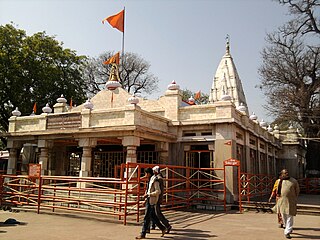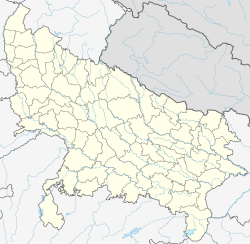Muzaffarnagar is a city under Muzaffarnagar district in the Indian State of Uttar Pradesh. It is situated midway on the Delhi - Haridwar/Dehradun National Highway and is also well connected with the national railway network. It is known as the sugarbowl of Uttar Pradesh.

Shahjahanpur is a municipal corporation, town and district headquarters of Shahjahanpur District in Western Uttar Pradesh, India.

Pilibhit is a city and a municipal board in Pilibhit district in the northern Indian state of Uttar Pradesh. Pilibhit is the north-easternmost district of Bareilly division, situated in the Rohilkhand region of the sub-Himalayan Plateau belt next to foothills of Sivalik Range on the boundary of Nepal, known for the origin of river Gomati and one of the most forest-rich areas in North India. Pilibhit was also known as Bansuri Nagari – the land of flutes, for making and exporting roughly 95% of India's flutes.

Shahjahanpur is a district of Uttar Pradesh India. It is a part of Bareilly division. It was established in 1813 by the British Government. Previously it was a part of district Bareilly. Geographically the main town is Shahjahanpur which is its headquarters. Its 4 Tehsils are: Powayan, Tilhar, Jalalabad and Sadar.

Lakhimpur Kheri district is the largest district in Uttar Pradesh, India, on the border with Nepal. Its administrative capital is the city of Lakhimpur.

Ghazipur district is a district of Uttar Pradesh state in northern India. The city of Ghazipur is the district headquarters. The district is part of Varanasi Division. The region of Ghazipur is famous mainly for the production of its unique rose-scented Spray called Gulab Jal, and for the tomb of the Governor General of British India, Lord Cornwallis, who died here. His tomb is situated in Western part of City, and is conserved by Archaeological Survey of India.

Parikrama or Pradakshina is clockwise circumambulation of sacred entities, and the path along which this is performed, as practiced in the Indic religions – Hinduism, Buddhism, Sikhism and Jainism. In Buddhism, it refers only to the path along which this is performed. In Indic religions, the parikrama is typically done after completion of traditional worship and after paying homage to the deity. Parikrama must be done with dhyāna.
Powayan or Pawayan is a town and a subdivisional headquarters in Shahjahanpur district in the Indian state of Uttar Pradesh, 27 km from Shahjahanpur, 47km from Tilhar. It is located in the fertile agricultural belt of Northern India and is 300 km from Delhi and 200 km from Lucknow.

Balrampur district is one of the district of the Indian state of Uttar Pradesh and is a part of Devipatan division as well as the historic Awadh regions. It has been cut from the adjacent district Gonda in 1997. Located on the banks of the West Rapti River. Balrampur is known for the temple of Pateshwari Devi, a Shakti Pitha, and for the ruins of the nearby ancient city of Sravasti, now a pilgrimage site for Buddhists and Jains. The nearest airport is Shravasti airport 23.3 kilometres (14.5 mi) from the town but it is not an international and regular airport; the nearest international and regular airport is Chaudhary Charan Singh International Airport in Lucknow, 235 kilometres (146 mi) away. Lucknow is the capital city of Uttar Pradesh and is 220 kilometres (140 mi) from Balrampur district headquarters.

Situated in the northern part of India, bordering with the capital of India New Delhi, Uttar Pradesh is one of the most popular and an established tourist destination for both Indians and non-Indians alike in India. The most populous state of India, Uttar Pradesh contains many historical monuments and places of religious significance. Geographically, Uttar Pradesh is very diverse, with Himalayan foothills in the extreme north and the Gangetic Plain in the centre. It is also home of India's most visited sites, Hinduism's holiest city, Varanasi. Kumbh city, Prayagraj. Kathak, one of the eight forms of Indian classical dances, originated from Uttar Pradesh. Uttar Pradesh is at the heart of India, hence it is also known as The Heartland of India. Cuisine of Uttar Pradesh like Awadhi cuisine, Mughlai cuisine and Bhojpuri cuisine are very famous not only in India but also many places abroad.
The demographics of Uttar Pradesh is a complex topic, which is undergoing dynamic change. Uttar Pradesh is India's most populous state, and the largest subdivision in the world. It has a population of about 199,812,341 as per the 2011 census. If it were a separate country, Uttar Pradesh would be the world's fifth most populous nation, next only to China, the rest of India, the United States of America and Indonesia. Uttar Pradesh has a population more than that of Pakistan. There is an average population density of 828 persons per km2 i.e. 2,146 per sq mi. The capital of Uttar Pradesh is Lucknow, and Prayagraj serves as the state’s judicial capital. Hindus and Muslims both consider the state as a holy place.
Dor Rajputs are a Rajput clan of India.

The Nat are a Hindu caste found in northern India.

Western Uttar Pradesh is a region in India that comprises the western districts of Uttar Pradesh state, including the areas of Rohilkhand and those where Hindi, Urdu and Braj are spoken; it is in the region of Western Uttar Pradesh that Hindi-Urdu originated. The region has some demographic, economic and cultural patterns that are distinct from other parts of Uttar Pradesh, and more closely resemble those of Haryana and Rajasthan states. The largest city of the region is Ghaziabad, while the second-largest city, Agra, is a major tourist destination.
Shahjahanpur is a town in the state of Uttar Pradesh in India, located about 25 kilometres from the district headquarters at Meerut. It has a population of 26075, the majority of whom are Muslim. There are also about 600 households of Hindus in the village, mainly belonging to the Jatav caste and other.
Dildarnagar Kamsar or Kamsaar, is a Pargana or a region of 32 places around Karamnasa river in Ghazipur district, and Kaimur District of Uttar Pradesh, India. Of whom main mouzas being 19. It is a large settlement of pathans mostly Khanzada Pathans and Afghan Pathans.
The second 'Legislative Assembly elections were held in Uttar Pradesh in 1957. The Indian National Congress won a comfortable margin with 286 of the 430 Vidhan Sabha seats, although it was less of a majority than in the previous election in 1951.

The 48 kos parikrama is a parikrama of various Mahabharata-related and other Vedic-era tirthas around the Hindu holy city of Kurukshetra in the state of Haryana, India.

Veer Vikram Singh, also known as "Prince", is an Indian politician of the Bharatiya Janata Party and a member of the 18th Uttar Pradesh Legislative Assembly. His native village is Dhabora Simra, Tehsil Tilhar Shahjahanpur.
Nawali is a village in Seorai tehsil of Ghazipur District, Uttar Pradesh, India.













